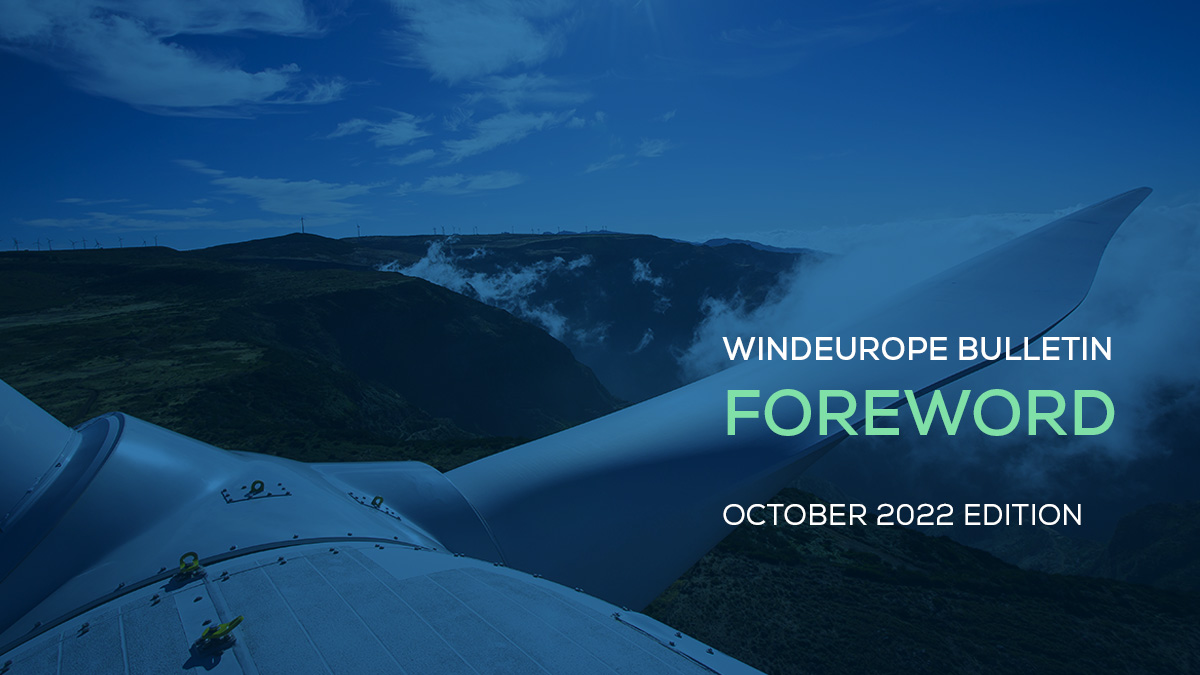News
WindEurope CEO on the EU’s new revenue cap on wind farms and developments on permitting

10 October 2022
CEO Foreword
Dear Member,
Gas and electricity supply continues to dominate politics in Europe. Governments are committing huge sums of money to protect consumers from high prices and scrambling to secure supplies especially of gas. At the same time they recognise that the expansion of renewables is the best way to improve Europe’s energy security long term.
The result is a paradox. Governments now want a massive build-out of wind, both onshore and offshore, in the years ahead. But they’re doing other things, notably in electricity markets, that could well work against that.
Two weeks ago EU Energy Ministers agreed new revenue caps for inframarginal electricity generation. They agreed an EU-wide cap of €180/MWh up to June 2023 (initially). BUT they also agreed they could deviate from this nationally AND that they could set different caps for different technologies. This raises the spectre of major uncertainty for investors. Which is the last thing Europe wants given the huge investments needed for the expansion of renewables.
The focus now shifts to how different Governments will implement the revenue cap. Our messages to them are:
- Keep the revenue cap technology neutral and ensure it incentivises investments in renewables.
- Do not apply revenue caps retroactively.
- Avoid changes to the cap once it’s set and give advance notice if the cap is going to be extended.
- Avoid capping and taxing the same revenue.
- Get generators to assess their revenues on a monthly basis, not less than that.
- Factor in how different revenue caps will affect cross border transactions.
More encouraging are developments on permitting. Germany is pulling out the stops to simplify the rules and procedures. France has instructed its regions to take urgent action to remove bottlenecks to new onshore wind. And the new UK Government has decided to back the build-out of onshore wind in England again. Meanwhile the European Parliament is debating new EU permitting rules: “overriding public interest, the population-based approach to species protection and a new approach to the 2-year deadline for permit decisions where the clock would start ticking once the EIA goes in. The Parliament has also voted for a definition in EU law of combined renewables projects, which would speed up the permitting and grid connection of wind/solar or wind/storage projects. More on all of this here.
Elsewhere Energy Ministers from the 9 North Seas countries met in Dublin and pledged to build 76 GW of offshore wind by 2030 and 260 GW by 2050. They focused on the supply chain aspects of this: how to get it back to profitability and then help it expand to meet these targets. They also called for steps to improve port and other infrastructure and workforce availability. Ambition on offshore wind continues to grow all over Europe. The commitments made by different Governments now add up to 165 GW by 2030.
The state of the European wind supply chain remains our main preoccupation. The European Commission are now clear that they need to support us. We’ve had good discussions on this with Frans Timmermans, and others in recent weeks. The German Government are focusing on it too. Our specific priorities are: getting public financial support for investments in plant, infrastructure and R&D; action on skills and workforce; improving auction design; getting a level playing field with China; and of course delivering on permitting to grow the market. I commend to you a recent White Paper from Siemens Gamesa which sets out the challenges and solutions very clearly.
Finally a word on our events:
- on 13 October we launch the 3rd phase of ETIPWind, the EU technology platform for wind that we run on the behalf of the Commission; and
- on 1-2 December is our annual workshop on end-of-life issues, EoLIS 2022, in Ghent. Repowering, lifetime extension and all the issues around decommissioning. Here’s the programme. And you can register here.
Take care.

Giles Dickson
Want to read more and receive our regular newsletters?

